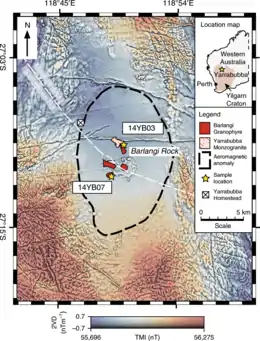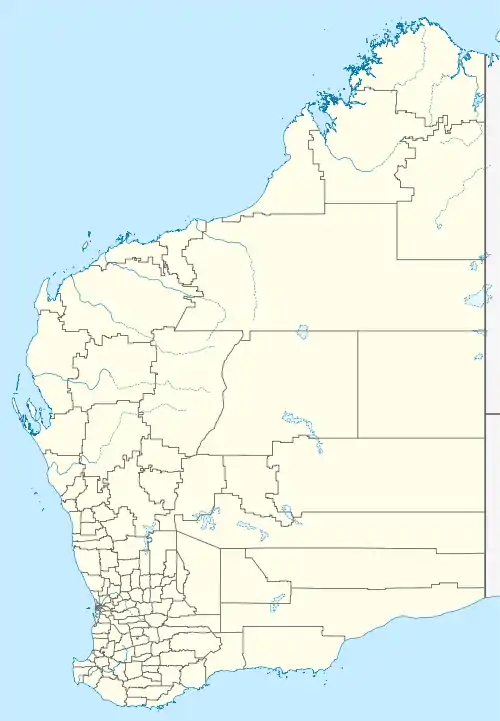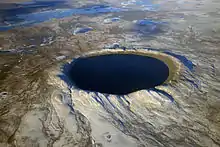Yarrabubba crater
The Yarrabubba crater is an impact structure, the eroded remnant of a former impact crater, situated in the northern Yilgarn Craton near Yarrabubba Station between the towns of Sandstone and Meekatharra, Mid West Western Australia.[2][3] With an age of 2.229 billion years, it is one of the oldest known impact structures on Earth.[1]
 Composite aeromagnetic anomaly map of the Yarrabubba impact structure[1] | |
| Impact crater/structure | |
|---|---|
| Confidence | Confirmed |
| Diameter | 30–70 km (19–43 mi) |
| Age | 2229 Ma Paleoproterozoic |
| Exposed | Yes |
| Drilled | No |
| Location | |
| Location | Yilgarn Craton |
| Coordinates | 27°10′56″S 118°50′04″E |
| Country | Australia |
| State | Western Australia |
| Municipality | Shire of Meekatharra |
 Location of the crater in Western Australia | |
Description
While the rim of original crater has been completely eroded and is not readily visible on aerial or satellite images; it is centered on a feature called the Barlangi Rock. The evidence for the extent of impact comes from the presence of shocked quartz and shatter cones in outcrops of granite interpreted to be near the centre of the original crater, and from geophysical data. The diameter of the original crater is uncertain, but has been estimated to be from 30 to 70 km (19 to 43 mi).[2] In simulations an impactor of diameter 7 km on ice over granite was found to produce a crater of final diameter compatible with the Yarrabubba crater.[1]
Age
The impact has been dated to 2,229±5 million years ago, making it the world's oldest confirmed impact crater.[1] This date places the impact at the end of the first period when the Earth was mostly or completely frozen, commonly called the Huronian glaciation.
The age finding was based on analysis of ancient crystals of the minerals zircon and monazite found in the crater. Scientists used uranium-lead dating to analyze the samples and to determine the age of the impact crater.[4][5][6][7][8]
See also
References
- Erickson, T.M., Kirkland, C.L., Timms, N.E., Cavosie, A.J., & Davison, T.M. (21 Jan 2020). "Precise radiometric age establishes Yarrabubba, Western Australia, as Earth's oldest recognised meteorite impact structure". Nature Communications. 11 (300): 300. doi:10.1038/s41467-019-13985-7. PMC 6974607. PMID 31964860.CS1 maint: multiple names: authors list (link)
- Macdonald F.A., Bunting J.A. & Cina S.E. 2003. Yarrabubba—a large, deeply eroded impact structure in the Yilgarn Craton, Western Australia. Earth and Planetary Science Letters 213, 235–247. Abstract
- Bunting J.A. & Macdonald F.A. 2004. The Yarrabubba structure, Western Australia—clues to identifying impact events in deeply eroded ancient cratons. Geological Society of Australia Abstracts 73, 227.
- Ancient Crystals Have Revealed the Oldest Meteorite Crater on Earth, The Yarrabubba impact structure in Australia dates back some 2.2 billion years, 200 million years older than any other known crater.] By Becky Ferreira, Jan. 21, 2020, vice.com
- Yarrabubba crater in WA outback world's oldest recognised impact structure, By Genelle Weule, Jan. 21, 2020, abc.net.au
- Earth’s Oldest Asteroid Impact Found in Australia, New York Times, Jan. 21, 2020.
- A 2.2-billion-year-old crater is Earth’s oldest recorded meteorite impact. The newly dated Yarrabubba crater is found in Western Australia. January 21, 2020.
- Oldest impact crater on Earth found and it could throw light on ancient climate change, Rob Waugh, Yahoo News UK, January 21, 2020.
External links
- Precise radiometric age establishes Yarrabubba, Western Australia, as Earth’s oldest recognised meteorite impact structure, Timmons M. Erickson, Christopher L. Kirkland, Nicholas E. Timms, Aaron J. Cavosie & Thomas M. Davison, January 21, 2020. Nature Communications volume 11.

